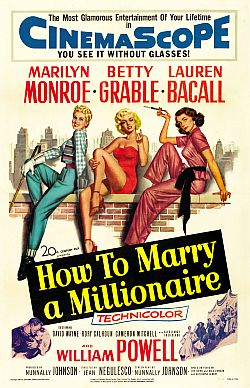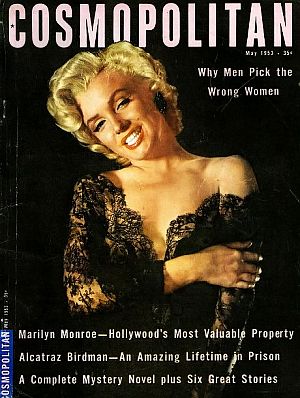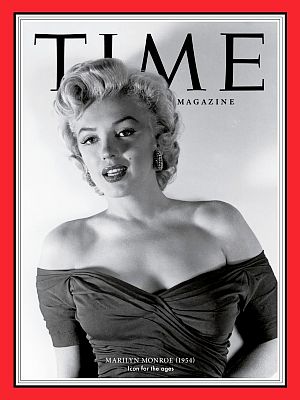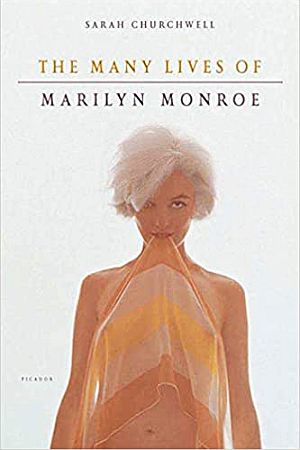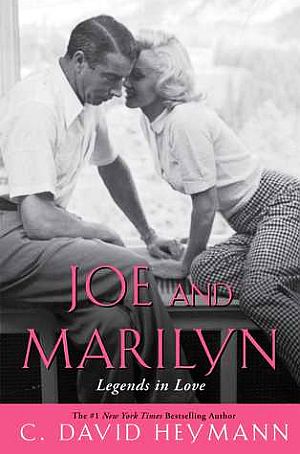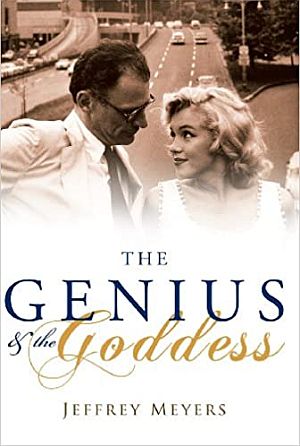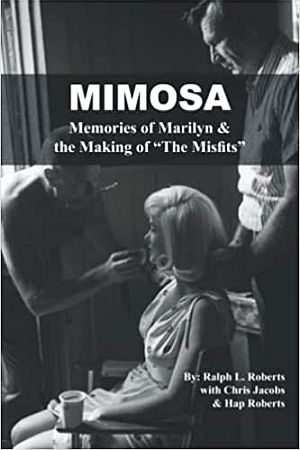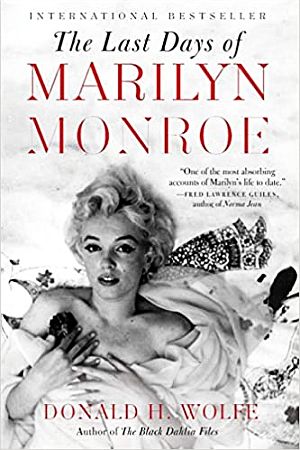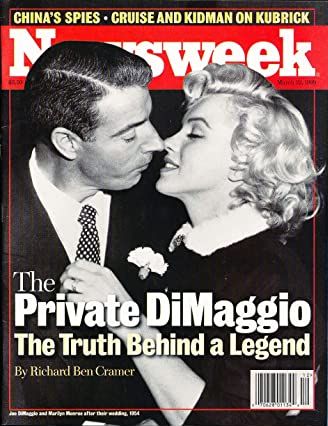
March 22, 1999. Newsweek cover story showing 1954 Joe DiMaggio / Marilyn Monroe wedding scene. Published shortly after DiMaggio’s death, it illustrates long-lived media interest & popular appeal of the “Joe & Marilyn” saga. Click for copy.
It was supposed to be the perfect, all-American, life-long love affair between two of America’s favorite people. Practically the entire nation of that day was taken up with this romance, most cheering that all would be well for Joe and Marilyn.
But alas, it was not to be; as theirs became a star-crossed love affair that ended in divorce. Still, over the years, there was a love and fondness between the two that lingered — and for Joe, the love continued even after Marilyn had tragically and prematurely died in her Hollywood home.
The Joe & Marilyn story, however, did not go away with the 1950s. Rather, it stayed alive, with continuing public interest fueled by periodic media coverage, books, and film — even to this day. In fact, the longevity of the Joe and Marilyn story – and the media’s continuing coverage of it (especially her) – is as much a part of the story as the two principals themselves. But first, some background.
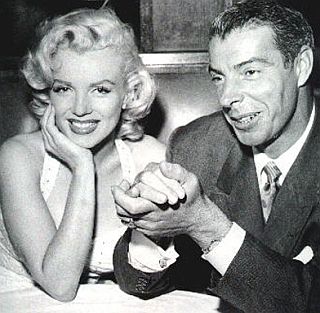
Marilyn Monroe and Joe DiMaggio in happy times, in the early thrall of their 1954 marriage.
Marilyn Monroe, who was first named Norma Jean Mortenson/Baker from southern California, would become one of Hollywood’s most iconic film stars and sex symbols. Born and raised in Los Angeles, Monroe spent most of her childhood in foster homes and an orphanage and had an early marriage at the age of 16. While working in a factory as part of the war effort during World War II, she met a photographer from the First Motion Picture Unit and began a successful pin-up modeling career. The work led to short-lived film contracts, and later, a full-fledged and famous Hollywood film career. Yet her work with a series of still photographers throughout her career would result in an equally, if not more important, artistic legacy.
In 1952, when DiMaggio first met Marilyn, he had recently retired from professional baseball, having been one of the nation’s most notable sports heroes through the 1940s. But through the 1950s and beyond, he remained much revered for his phenomenal 13-year career with the New York Yankees. What follows below are profiles of both DiMaggio and Monroe, and in order of career, Joe first followed by Marilyn, then their relationship, marriage, divorce, aftermath, and continuing media interest.
Joltin` Joe
Joe DiMaggio made his major league debut with the New York Yankees on May 3rd, 1936, batting ahead of another baseball titan, Lou Gehrig. But DiMaggio soon left his mark on baseball in a big way. His famous 56-game hitting streak – from May 15th through July 16, 1941, still a record today – put him in a category all his own. Beyond that, he had a stellar career: a three-time winner of the Most Valuable Player (MVP) award.(1939, 1941, 1947) and selected to the All-Star team every year he played, for 13 years.
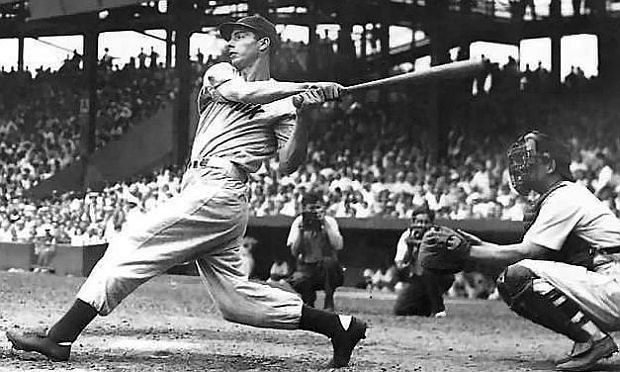
Joe DiMaggio of the New York Yankees, shown here during his prime playing years, exhibiting one of the most productive and near-perfect batting swings in baseball history.

|

|

|
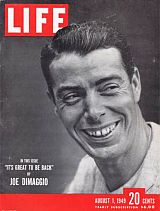
|

|

|
In his defensive play, DiMaggio was also considered a good ballplayer who had deceptive speed, capable of covering lots of ground in centerfield. In 1939, he was dubbed the “Yankee Clipper” by Yankee stadium announcer Arch McDonald, for his speed and range in the outfield, being compared to the then-new and culturally-topical Pan American “Clipper” airliner.
By 1949, DiMaggio would sign a record contract with the Yankees that made him the first baseball player to break $100,000 in earnings, then a huge amount of money for a sports star, equivalent to about $1 million or more in current dollars.
At the time of his retirement in December 1951, DiMaggio had the fifth-most career home runs at 361 and the sixth-highest slugging percentage at .579. During his thirteen year career, the Yankees won ten American League pennants and nine World Series championships. DiMaggio is still among a handful of players who compiled at least four seasons of 30-homers and 100-RBIs in their first five years of play. But it is DiMaggio’s famous 56-game hitting streak is considered one of baseball’s most remarkable records and amazing feats; one that has stood the test of time for more than 80 years, with few players able to reach even 30- or 40-consecutive game hitting streaks. The closest anyone has ever come to equaling DiMaggio since 1941 was Pete Rose, who hit safely in 44 straight games in 1978.
“Joltin’ Joe’s” feat was coined in a 1941 hit song by that name by the Les Brown Orchestra, and celebrated by generations of fans ever since.
DiMaggio, of course, was a sports celebrity of his day, and as such, he was much in the news, appearing on sports and major circulation magazines of the day, including Time, Life, Look and others, and as sampled above, from top to bottom: Life, May 1939; Sport, September 1948; Time, October 1948; Life, August 1949; Sports World, May 1949; Sport, September 1949. But in the early 1950s, Joe DiMaggio was a single man. Earlier in his career, he had married actress Dorothy Arnold in November 1939, and the couple had a son in 1941. However, they divorced in 1944.

|

|
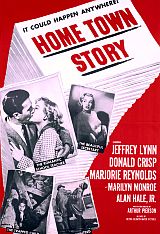
|

|
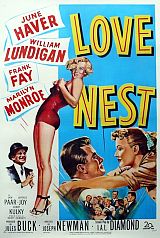
|

|
Marilyn Monroe
Marilyn Monroe, meanwhile, had been working in modeling while trying to break into acting. Although she had small parts in several films in the late 1940s, including playing a waitress in the 1947’s Dangerous Years, Monroe didn’t begin to be noticed until 1950 with two films in particular: The Asphalt Jungle, a John Houston film in which Monroe played a gangster’s moll (poster at left came some years later, after Monroe was a bigger star), and All About Eve, which starred Bette Davis and Anne Baxter (click images for Amazon.com pages).
By December 1950, Monroe had secured a seven-year contract with 20th Century-Fox, a basic contract that gave her little control. Still, she was on her way with a major film studio.
In 1951, four low-budget films helped bring her more notice: Home Town Story (May), and three comedies – As Young as You Feel (August ), Love Nest (October), and Let’s Make It Legal (November). Although her roles in these films cast her essentially as “a sexy ornament,” according to one account, she did receive some praise for her acting from critics such as Bosley Crowther of the New York Times and Ezra Goodman of the Los Angeles Daily News, the latter describing her in a review of Love Nest as “one of the brightest up-and-coming [actresses]”.
Monroe’s popularity with audiences was also growing: she received several thousand fan letters a week, and was declared “Miss Cheesecake of 1951” by the army newspaper Stars and Stripes, reflecting the preferences of soldiers in the Korean War. In February 1952, the Hollywood Foreign Press Association named Monroe the “best young box office personality”.
In her private life at this point, Monroe had no steady man in her life, but had been dating a number of men in Hollywood, including actors Yul Brynner and Peter Lawford, director Nicholas Ray, and also had a short relationship with director Elia Kazan. But then came Joe DiMaggio.
“Who’s The Girl?”
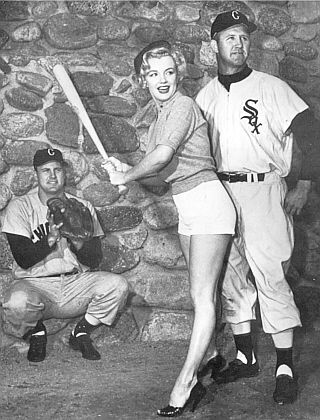
Marilyn Monroe in 1951 publicity photo posing in a batting stance with Chicago White Sox players Joe Dobson and Gus Zernial.
Monroe wasn’t at all sure she would be interested in a baseball player, and didn’t know much about baseball, DiMaggio, or how big of star he had been. Still, she agreed to come, but only if Dave March would also be there with his guest.
Marilyn, meanwhile, would receive some insight on exactly who Joe DiMaggio was from her friend, Hollywood columnist Sidney Skolsky. Skolsky told her that DiMaggio was hugely popular and hugely admired. He was, as Skolsky put it, a really Big Name – a guy with dignity and class who had the public’s respect. Joe DiMaggio, he informed her, was national hero. And for Marilyn Monroe at that stage of her career, that was not a bad thing.
On their dinner date, Monroe, who typically arrived late for most things, was late this time as well, by two hours. She was then involved in the production of a the film Monkey Business, starring Cary Grant and Ginger Rogers. Dave March suggested she was probably held up on the set. March called her from the restaurant, and Marilyn tried to beg off, saying she was worn out from work, but relented under March’s pleadings. At dinner, Joe and Marilyn had few exchanges, and Marilyn was a bit mystified by Joe’s reserved manner and relative quiet. They barely spoke to one another. Their dinner was interrupted for a time by actor Mickey Rooney who pulled up a chair and began talking baseball. A couple of other patrons at the restaurant also recognized DiMaggio, and Marilyn was seeing that this guy had something of a following. But she noticed he was silent as the admirers spouted his statistics. She also observed DiMaggio’s impeccable dress and appearance, which was not like she had expected, thinking he might have been a more flamboyant dresser. Instead, she thought he dressed more like a business man. Joe DiMaggio, in fact, although quiet and somewhat awkward in appearance, still had a presence about him and projected power, or as one friend would note, “he still managed to command the whole room”.
In any case, Marilyn tired of the baseball talk and the evening’s direction; she decided to excuse herself and head for home. Joe then rose as well, asking to see her to the door. As he walked her to her car, he asked for a lift to his hotel and she agreed. Her car was a mess, backseat overflowing with books, scripts, some parking tickets and other material. But as they approached DiMaggio’s hotel, he said he wasn’t interested in turning in just then, and they proceeded to drive around a bit in her car. That’s when Joe began opening up, telling her his whole life story, about his immigrant family, their hard times and modest life, his baseball career, and more. They drove around Beverly Hills that night for about three hours. By the time they arrived at the Beverly Carlton where Marilyn was staying, she invited him in. The next day he phoned her and later sent her a bouquet of roses. When Dave March asked him how the evening went, he reported “pretty damn well.”
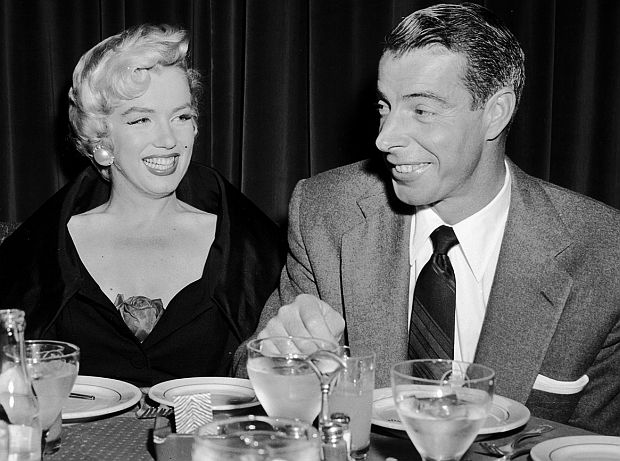
Marilyn Monroe and Joe DiMaggio at a later 1954 restaurant outing in New York city at the El Morocco. During their courtship, Joe had also brought Marilyn to Toots Shor’s and other famous Manhattan haunts for celebrities of that era.
Around the time she first dated DiMaggio, however, Monroe found herself at the center of a bit of a scandal, as a 1952 calendar was published with some pin-up styled photos of Monroe in the nude (the calendar, reportedly, had sold 6 million copies). The photos were from 1949, and according to one later account in Time magazine, “her bosses at the film studio ‘begged her’ to deny that the woman in the photo was her, but she wouldn’t do so. That turned out to be a move that only increased her star power.” Monroe spoke frankly to a news reporter about what had happened. She explained that she was broke and an aspiring actress at the time in 1949 when she was paid for the photo shoot. Her story received wide notice and it gained her public sympathy. It also didn’t hurt that at the time she was appearing in the news with national hero, Joe DiMaggio. In any case, the revelation of her old calendar photos increased interest in her films, for which by then she was receiving top-billing. It also brought her more media attention.
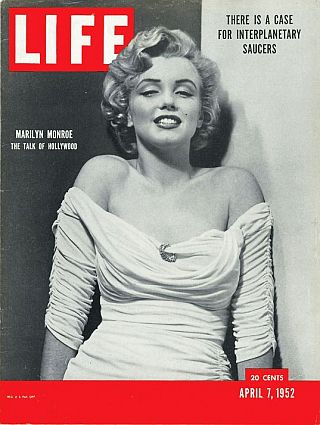
Marilyn Monroe on the cover of Life magazine, April 7, 1952, with story tagline, “Marilyn Monrore: The Talk of Hollywood,” about her up-and-coming stardom, in photograph taken by Philippe Halsman, remains one of the most famous and collectible covers in the history of the magazine.
…Every so often, more in hope than conviction, Hollywood announces the advent of a sensational glamour girl, guaranteed to entice people from all lands to the box office. Usually the sensation fizzles. But today the most respected studio seers, in a crescendo of talk unparalleled since the debut of Rita Hayworth, are saying that the genuine article is here at last: a sturdy blonde named Marilyn Monroe.
In addition, gossip columnist Hedda Hopper declared Monroe as the “cheesecake queen” turned “box office smash.” That summer of 1952, to capitalize on the rising public interest in the new actress, Fox studio released three of Monroe’s films — Clash by Night (June 16), We’re Not Married! (July 11th) and, Don’t Bother to Knock (July 18th). Two other films with Monroe, Monkey Business and O. Henry’s Full House, came out later that year, further boosting her career.
Joe DiMaggio, meanwhile, continued his courtship of Monroe during the summer of 1952, as the two began to date more regularly. They had something of a bicoastal relationship at the time – Marilyn in Hollywood and Joe in New York, then as a baseball sportscaster. But by late May 1952, Marilyn came to New York for the filming of Niagara, and would see Joe during that period.
During that summer, however, some red flags were being raised by a few of Monroe’s concerned friends. Joe didn’t really like her career, and thought women should be firmly in the home. DiMaggio was also jealous of the attention she generated from other men. Still, in July 1952, the baseball star took the Hollywood beauty home to San Francisco to meet his family. Once there, Marilyn clearly saw why Joe wanted his wife to be domestically set. In the DiMaggio family, women raised children, cooked and cleaned, and it had always been that way – and that’s what Joe wanted. He had been raised in a home of Sicilian immigrants, with strict Catholic values and a family credo that stressed a strong work ethic and pride in their Italian heritage.
The V-Cut Dress
In September 1952, Marilyn came east for the premiere of Monkey Business, and also to serve as Grand Marshal for the Miss America Pageant in Atlantic City. For the latter occasion, she wore a black chiffon dress with a v-shape front, cut to the navel and bare back.
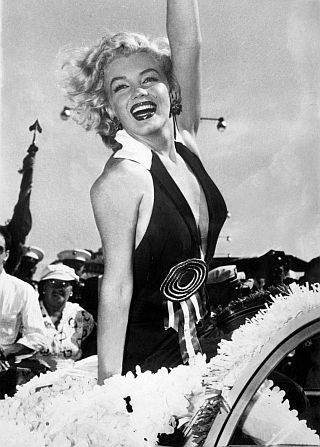
September 1952. Marilyn Monroe in v-cut-to-the navel dress at Miss America Pageant parade in Atlantic City, NJ.
Still, according to a later book by Ben Cramer, Joe was quite angry, telling her it made her look like a whore. “Show them nothing,” he said to her, and “wear your own goddamn clothes…” She was back in Los Angeles by then, and Joe’s words had come to her over the phone. But once he settled down, he felt bad about his anger and tried recalling her, to no avail. Marilyn wouldn’t answer the phone. So Joe just dropped everything and flew out to Hollywood. He later took her clothes shopping, and they patched things up a bit. But for Marilyn, no doubt, some scars remained. Joe later took her to San Francisco where they would spend time with Joe’s family, which Marilyn enjoyed, as well as when she toured the city with Joe on visits there.
But Joe DiMaggio was a man not at ease with the career of Marilyn Monroe. In fact, at the end of summer of 1952, he had made something of bombshell proposal: that it might be best if Marilyn abandoned her acting career. If it only caused her stress, he is reported to have said, why should she do it?According to Stacy Edwards, a Philadelphia sportswriter who knew DiMaggio quite well, “Joe was sick and tired of Marilyn’s career,” and he wanted to get her out of the movies.
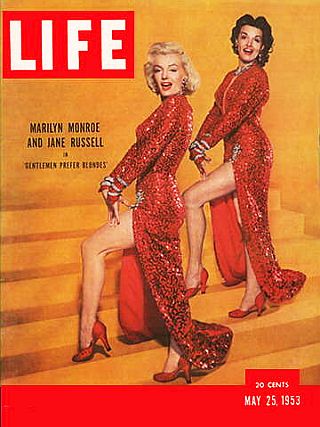
Marilyn Monroe and Jane Russell, co-stars of the film, “Gentlemen Prefer Blondes,” appeared on the cover of Life magazine in May 1953, in advance of the film’s release that July.
In fact, by 1953, Marilyn’s career only soared higher, scoring some of her biggest films. She had three hit films that year: Niagara, Gentlemen Prefer Blondes, and How to Marry a Millionaire. Niagara, released in January, sent her into the Hollywood firmament, establishing her as one of the movie industry’s biggest draws. Her sultry sexuality was shocking to some, seductive to others.
In advance of Gentlemen Prefer Blondes, slated for July 1953, Monroe and Jane Russell, co-stars of the film, appeared on the cover of the May 25th edition of Life magazine.
In Life’s story, titled “Marilyn Takes Over As Lorelei,” Monroe’s performance as the Lorelei Lee character – from the 1925 comic novel, Gentlemen Prefer Blondes by Anita Loos – was briefly profiled. The story ran with several photos, noting, in part: “In the new 20th Century Fox version, Marilyn sings and dances with a surprising technical competence… In her biggest number she spurns a whole panel of penniless and prostrate admirers and gives the fallen forms the benefit of her philosophy of life: ‘Diamonds Are A Girl’s Best Friend’.”
Marilyn’s “Me Too”
Marilyn Monroe, however, was a woman who knew what was going on, and how the Hollywood system treated women in the business. In 1952-53 she had written a story titled, “Wolves I Have Known,” (as told to journalist Florabel Muir). Marilyn’s story was published in the January 1953 edition of Motion Picture and Television Magazine, which included Marilyn on the cover. Other versions of the story had been published earlier, appearing for a broader public audience in The Daily News newspaper of New York City (see ad below). The article offered her take – from personal experience – on certain types of men, or “wolves” as she called them, that she met in Hollywood while seeking work as an actress.
 Jan 1953. Marilyn Monroe on cover of “Motion Picture” magazine for story, “Wolves I Have Known”. |
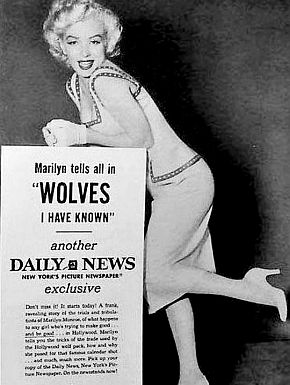 “Daily News” ad for Monroe “Wolves” story, earlier versions of which also ran in September 1952. |
In the article, she described how things really worked for young girls in Hollywood at that time trying to break into acting. Or as the Daily News put it in one ad: “…A frank, and revealing story of the trials and tribulations of Marilyn Monroe, of what happens to any girl who’s trying to make good ….and be good … in Hollywood. Marilyn tells you the tricks of the trade used by the Hollywood wolf pack, how and why she posed for that famous calendar shot…and much, much more…”
Marilyn didn’t name names in her piece, but the point was made: young girls with their eyes on Hollywood were often sexually harassed, propositioned, or offered unseemly quid pro quos or ultimatums for screen tests, bit parts, or pie-in-the-sky promises that never panned out. Hollywood then, and still today, noted as the land of the casting couch.
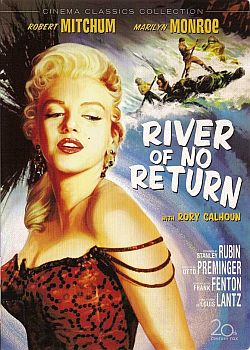
“River of No Return,” not a happy film for Monroe, still became a hit in April 1954. Click for film.
Joe to The Rescue
Around the time Gentlemen Prefer Blondes began appearing in theaters in July 1953, Monroe was working on another film, River of No Return, with co-star Robert Mitchum, a western set in the American Northwest in the 1870s. The film was part of her contract with 20th Century Fox, nearing the end of a seven-year run, during which the studio had capitalized on her growing popularity without giving her added benefits or pay. In fact, for River of No Return, she was paid as a contract player.
River of No Return was directed by Otto Preminger and filmed in the Canadian Rockies. By August 1953, Marilyn was on location in Calgary for the filming, and later in Alberta at the Banff Springs Hotel in Banff National Park, also in the Rockies.
But during the filming, Marilyn, along with her acting coach, Natasha Lyetess, had driven director Preminger into some despair in getting things done. Marilyn had also sustained an ankle injury during one scene, and had to be pulled out of a river at one point.
Unhappy with the film, she telephoned DiMaggio, who was soon on his way to Canada to be at her side. DiMaggio claimed to be on a fishing trip when queried by the press. Marilyn by then was wearing an ankle cast from her injury and was helped around by Joe.
After the filming was completed, Joe and Marilyn took some R&R at the Banff Springs Hotel, where they met up with John Vachon, the staff photographer for Look magazine, who had been sent to the Canadian Rockies on assignment, as a number of actors and celebrities were in the area on other Hollywood film projects in addition to River of No Return. In any case, a number of photos of Joe and Marilyn were taken at that time, including the one shown here below.
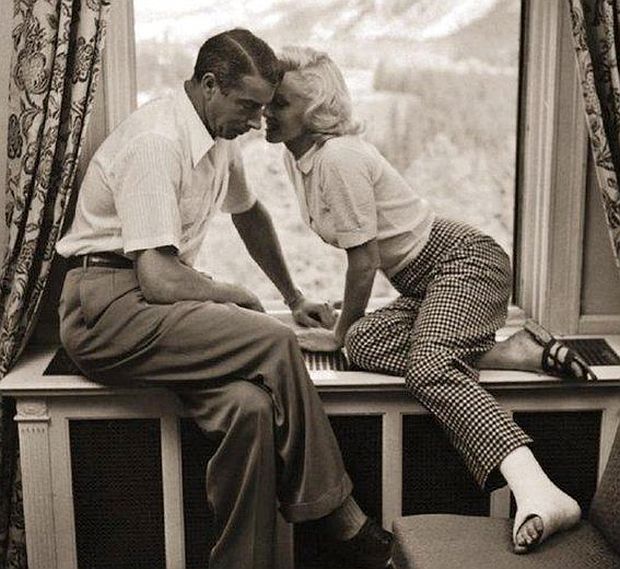
August 1953. Joe DiMaggio and Marilyn Monroe (with ankle cast) photographed in window seat at the Banff Springs Hotel in Banff National Park, Alberta, Canada, by Look magazine photographer, John Vachon.
In Banff, Joe and Marilyn had been talking about their future together and the direction of Marilyn’s career. Joe had a dim view of Hollywood and its culture all along, and believed Marilyn was underpaid and exploited by the studio, as well as some of those around her, including acting coach, Natasha Lyetess. Joe believed Marilyn should play a little more hard ball with the studios, and he would soon play a more prominent role in helping her do that – at least for the next year or so. In August 1953, as their time together in Banff ended, he flew back to L.A. with Marilyn, and then returned to New York, set to play in an Old Timers game at Yankee Stadium.
By November 1953, Marilyn’s earlier made film, How to Marry a Millionaire was in theaters and was getting decent reviews.Toward the end of 1953, according to the trade press of that day, Monroe was making more money for her studio than any other actress in Hollywood.
At 20th Century, Darryl Zanuck wanted to put Marilyn in another film, The Girl in The Pink Tights, along with Frank Sinatra. But Marilyn did not like this film, or her casting as another “dumb blonde,” and Joe agreed.
In fact, she and Joe had been discussing her relationship with the studio, and agreed that she should make no more film deals until she received better treatment – better pay, mostly in Joe’s view. Marilyn was more interested, as always, in having more control over role, script and directors.
So, in the latter part of 1953, with Joe’s insistence and support, she would defy the studio and not appear for Girl in the Pink Tights filming. Zanuck was apoplectic, and tried all sorts of maneuvers and threats to have her comply. But with Joe’s backing, she held her ground, although there were some tenuous moments.
She had to return to Los Angeles for some last-minute shooting for River of No Return, and there she began to worry about maybe being shut out of Hollywood if she did not comply. But in the end she did not give in, and by the end of December 1953, she returned to San Francisco where she would spend the holidays with Joe and his family.
Playboy

Dec 1953. First issue of Playboy magazine featured Marilyn Monroe on its cover and inside centerfold – launching Hugh Hefner’s national magazine for men and subsequent business empire of Playboy clubs & culture.
The Playboy cover image of Monroe was a photograph taken at the Miss America Pageant parade in 1952 in the V-cut dress that DiMaggio had a fit about. But that photo wasn’t the main event. The magazine’s nude centerfold was.
That soon-to-be famous regular feature of the magazine, first called “Sweetheart of The Month,” but soon changed to “Playmate of the Month” – would become the magazine’s main draw for “male entertainment.”
In any case, the featured Monroe nude came from the notorious 1949 photo shoot of Monroe on a background of red velvet by Tom Kelley, mentioned earlier. On the magazine’s cover, Hefner played up the special content with an inset box to the right of Marilyn waving that said: “First Time in Any Magazine the Famous Marilyn Monroe Nude”
Monroe hadn’t consented to Hefner for Playboy’s use of the four-year-old nude photo, nor had Hefner directly paid Monroe any money for the photo’s use. Hefner purchased the rights to Monroe’s nude photos from the Chicago-area company in fall 1953 for a reported $500. But that Playboy edition with centerfold – which quickly sold out – helped launch the new magazine and Hefner’s subsequent business empire of Playboy clubs and culture. True, for Monroe, it also helped advance her image as a leading sex symbol. It is not clear how Joe reacted to Marilyn’s notice with Playboy, though given his earlier concerns, he was likely not happy about it.
Marriage & Honeymoon
Joe and Marilyn had talked about marriage since September 1953. But on New Year’s Eve 1953, Joe made it official and proposed to her and she consented. But Marilyn at the time reportedly made a somewhat macabre request of Joe: if she died before him, would he promise to place flowers at her grave every week? He so promised – and years later would faithfully fulfil the pledge without fail. As a Catholic Joe wanted a church wedding, but with his divorce from his first wife, the Catholic church in San Francisco refused. So they opted instead for what Joe hoped would be a quiet civil ceremony, as wedding plans were kept quiet.
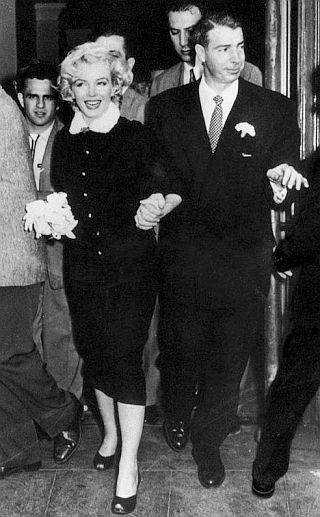
Marilyn Monroe and Joe DiMaggio emerging from their civil ceremony marriage in San Francisco, January 14, 1954.
When word about the ceremony spread, it created a firestorm of publicity. The couple were mobbed by a crowd of 500 onlookers and reporters. They soon departed the scene in Joe’s dark blue Cadillac to the Clifton Motel in Paso Robles, California. The next two weeks were spent at a mountain hideaway outside of Idyllwild, near Palm Springs, California. But the main part of their honeymoon would be in Japan – the result of some baseball business Joe had previously agreed to.
According to Liesl Bradner, writing a story on the DiMaggio/Monroe trip to Japan for HistoryNet.com, before the marriage, DiMaggio had agreed to accompany an old friend and former minor league coach, Frank “Lefty” O’Doul, to help train Japanese baseball teams in Japan for their up coming season. O’Doul, also a native of San Francisco, had been DiMaggio’s manager with the minor league San Francisco Seals, where DiMaggio had starred before coming to the Yankees. O’Doul, also recently remarried, brought his new wife, Jean, on the trip as well.
On the flight to Tokyo, they traveled in style, on Pan Am’s luxurious Stratocruiser airliner, dubbed “the Flying Hotel,” which featured a spiral staircase, single beds, and dressing rooms. Nine hours into the flight, during a short stopover in Honolulu, an enormous crowd turned out at the airport there on word that DiMaggio and Marilyn Monroe were aboard. In Tokyo, as well, there were large admiring crowds, turned out more for Monroe than DiMaggio.
But earlier, on their flight into to Tokyo, just as they were making the decent to land, a U.S. Army officer, in the upper echelons of the Far East Command, approached DiMaggio and Monroe at their seats in the cabin to ask a question. “How would you like to visit Korea for a few days and entertain the American troops currently stationed in Seoul as part of the UN occupation force?” DiMaggio at first thought the questioned was directed at him, and he declined. But the Major General was really asking Monroe. And she first asked Joe what he thought and he replied, that it was her choice, but it was also her honeymoon. Nevertheless, Monroe accepted the offer.
Marilyn, accompanied by Jean O’Doul, left for Korea in February of 1954 to entertain the troops. She would do a four-day USO tour performing ten shows for more than 100,000 servicemen. On the tour, Marilyn was overwhelmed by the enthusiasm of the soldiers and buoyed by their reception. But she reminded everyone she was married, telling a crowd at one point she was sorry Joe couldn’t’ be with her in Korea. Still, she would always mark the trip to Japan and Korea as the moment when she realized that she was truly an international star.
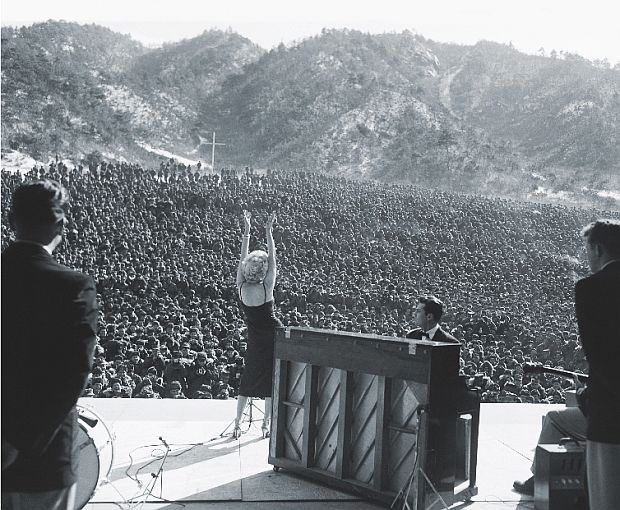
February 1954. Marilyn Monroe, center stage, entertaining U.S. troops in Korea, at one of the ten USO shows she did there during a four-day tour of U.S. troop bases.
Returning to Japan after the four-day Korean tour, she remarked to her new husband: “It was so wonderful Joe, you’ve never heard such cheering!” But to that, Joe is said to have replied, “Oh yes I have.” Joe was realizing what being married to Marilyn Monroe would really be like. The honeymoon was over.
After returning to the U.S., Monroe’s career continued its upward trajectory. She received the “Most Popular Female Star” award from Photoplay magazine. By March 1954, she had the promise of a new contract with Fox Studios, a bonus of $100,000, and a starring role in the proposed film adaptation to come for a Broadway stage play titled, “The Seven Year Itch.” In April 1954, River of No Return in the new CinemaScope format, began appearing in theaters and became popular with audiences. She was also working on other films, including a musical, There’s No Business Like Show Business. But in September 1954, she began filming The Seven Year Itch, playing a woman who becomes the sexual fantasy of her married neighbor, played by Tom Ewell.
Seven Year Itch
“The Seven Year Itch” was shot mostly in Hollywood, but the studio wanted to generate advance publicity for the film by staging one scene with Monroe and Ewell on the streets of New York – a scene with Monroe standing over a subway grate with subway air from below blowing her white dress high up in the air. This scene would become controversial, and a “last straw” of sorts for the controlling and jealous DiMaggio.
The scene was shot on Lexington Avenue in Manhattan. The film’s publicity department revealed the time and location of the shooting and throngs of onlookers and photographers showed up. Director Billy Wilder shot over a dozen takes of the scene as the crowd became more boisterous and unruly. The shoot lasted for several hours and attracted nearly 2,000 spectators, by one count.
 Marilyn Monroe during filming of the “subway grate scene” for “The Seven Year Itch” film, Sept 1954, New York. |
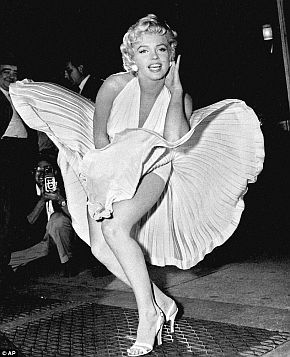 Another in the sequence of photos taken during the filming of the “subway grate scene”. |
Among the onlookers, however, was Joe DiMaggio and gossip columnist Walter Winchell, who had encouraged him to come to the scene. As they watched the shootings, DiMaggio grew progressively irate at the sight of his wife being ogled and cheered on by the crowd. Reportedly, after the shoot, there was angry shouting match (and rumored physical abuse) between the couple at the St. Regis Hotel, where they were staying. They later returned to their rented home in Los Angeles, where arguments between the two continued.
The “subway grate scene,” meanwhile, became one of Monroe’s most famous, plastered across newspapers and magazines, and used extensively in advertising to promote the film, including a giant billboard-size likeness of Monroe in the famous pose used above a Lowes theater in Manhattan (photo below). The film would become one of Monroe’s biggest commercial successes at its release (the film’s premiere, however, did not come until June 1st, 1955, Monroe’s 29th birthday).
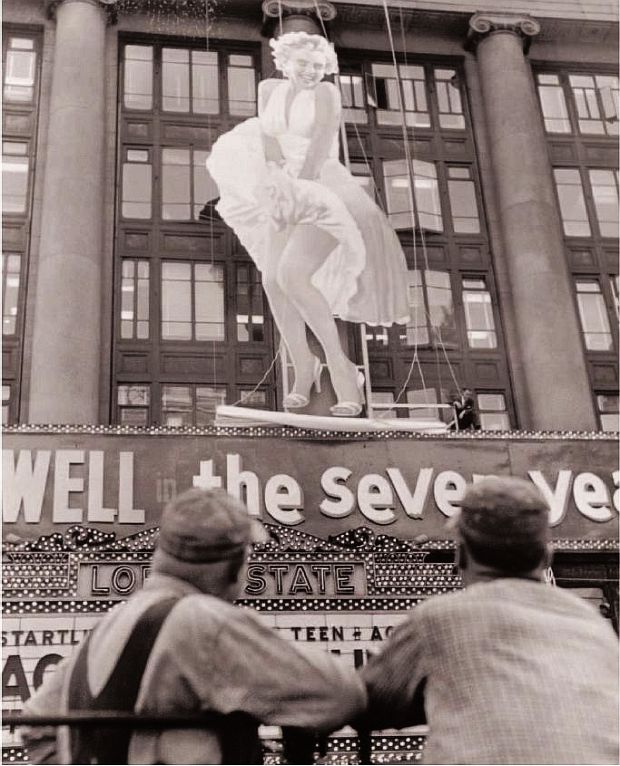
Huge cut-out figure of Marilyn Monroe in her famous "subway grate" pose is set into position above a Lowes Theater in New York City to promote the 1955 film, The Seven Year Itch, as two workmen observe the scene..
Back in Hollywood, at the home she and Joe shared, there were more arguments between the couple. However, on October 6th, 1954, Monroe — with her attorney standing beside her outside the home — announced to reporters that she intended to file for a divorce from Joe DiMaggio on the grounds of “mental cruelty.” Joe had packed up and departed earlier from their home, heading to San Francisco. A divorce hearing was held some weeks later, on October 27th, 1954 and the final divorce decree would be granted the following year.
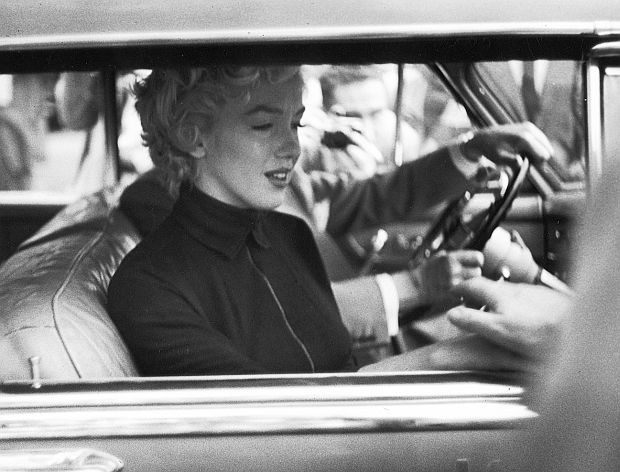
October 1954. A tearful Marilyn Monroe in car with her attorney after announcing to the Hollywood press her intention of seeking a divorce from Joe DiMaggio.
Before the divorce was final, however, DiMaggio had hired a private investigator to follow Monroe, as he suspected she was seeing another man. According to one New York Times account, on November 5, 1954, DiMaggio was having dinner in Los Angeles with Frank Sinatra and others when they heard from the investigator that Monroe was with another man at an L.A. apartment complex. DiMaggio, Sinatra, and a couple other men then departed the restaurant and drove to the apartment house where they believed the tryst was in progress. There, reportedly, a door was kicked in, with flash cameras at the ready, only to find an outraged woman resident in her nightgown – a woman who later sued the invaders, gaining an out-of-court settlement.
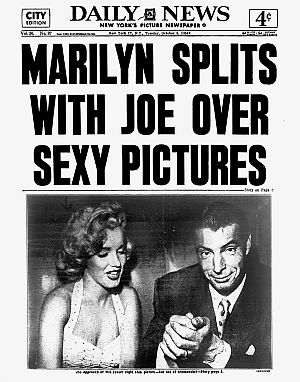
Oct 5, 1954. Some of the press coverage that followed the “subway grate” photo shoot and resulting separa-tion and later divorce between Joe and Marilyn.
“I never for a minute believed that she and Joe DiMaggio would last,” Jane Russell is reported to have said. Marilyn and Jane were co-stars in the film, Gentlemen Prefer Blondes, and Joe and Marilyn were friends with Jane and her husband, Bob Waterfield, an all-pro quarterback with the Los Angeles Rams. “They were in love, very much so,” said Russell of DiMaggio and Monroe, “but they didn’t understand each other. They came from different universes. That was the tragedy of their relationship. They couldn’t stay together. It was ill fated, written in the stars.”
Not long into the marriage, in fact, Monroe had called an old friend and actor, Brad Dexter, telling him she was extremely unhappy. “I married Joe with love,” she said. “I thought I was going to have a good life… And all the things that are entailed in a good marriage.” But instead, she explained, “I’ve discovered that the man is absolutely obsessed with jealousy and possessiveness… He doesn’t want to know about my business. He doesn’t want to know about my work as an actress. He doesn’t want me to associate with any of my friends. He wants to cut me off completely from my whole world of motion pictures, friends, and creative people that I know.”
She would later tell a judge in a Santa Monica courtroom why her marriage to Joe wasn’t working out. His “cruel indifference,” she said, had driven her to divorce. “Your honor, my husband would get in moods where he wouldn’t speak to me for five to seven days at a time — sometimes longer, ten days. I would ask him what was wrong. He wouldn’t answer, or he would say, ‘Stop nagging me!’ I was permitted to have visitors no more than three times in the nine months we were married. . . ”.
Marilyn’s Redesign
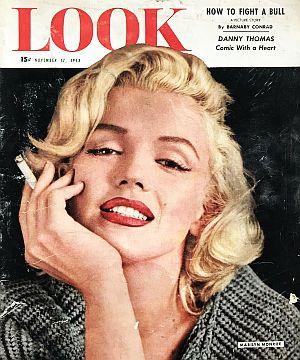
November 1953. Look cover of MM; early example of the 5,000+ photos Milton Greene would shoot of her.
In the fall of 1953, Greene had a photo shoot with Marilyn, and the two became fast friends. One of Greene’s shots of Marilyn appeared on Look magazine’s cover of November 1953 (over the years in shoots with MM, Greene would amass some 5,000 photos of her, some quite famous).
Following her separation from DiMaggio, Marilyn was grappling with what to do next, still battling with her studio, and Greene suggested she come East to New York city to pursue her craft. In fact, off and on, for the next two years or so, she would live with Greene, his wife, and their young son in Connecticut. But she and Greene would also create Marilyn Monroe Productions (MMP), her own production company, designed to give her more contract leverage with the film studios and better role choices.
By early 1955 MMP had been created, and on April 8,1955, Monroe appeared on the famous Edward R. Murrow TV show, Person to Person – a show filmed at Greene’s home, along with Greene and his wife, Amy, who joined Monroe during the interview. Murrow asked Milton about the new production company he and Marilyn had formed and if they had received any offers. Greene responded that yes, there had been “quite a few” – some from TV, the theater, movies, books, and others. Murrow also asked Marilyn about the company, and she answered she was only interested in making good films, and wanted to try something different. “It’s not that I object to doing musicals and comedies,” she replied, “in fact, I rather enjoy them – but I’d like to do dramatic parts, too.”
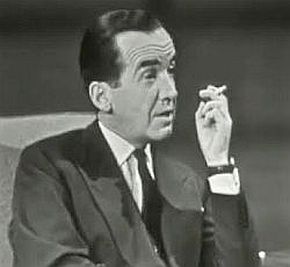 Edward R. Murrow in a familiar pose with cigarette as he interviews guests on “Person-to-Person”. |
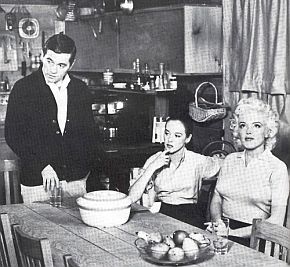 Milton & Amy Greene, along with Marilyn Monroe, during “Person-to-Person” show of April 1955. |
The Murrow show was very popular at the time, and Marilyn’s appearance and mention of her production company was a direct shot across the bow of the studio moguls in Hollywood. But initially the press had regarded MMP as something of a joke, believing Monroe could not stand up to the all-powerful Hollywood studio system. But later, her company would produce two films and be credited with helping bring down the studio system. By the end of 1955, Monroe and Fox signed a new seven-year contract. Fox would pay her $400,000 to make four films, and granted her the right to choose her own projects, directors and cinematographers. She would also be free to make one film with MMP for each completed Fox film.
 Marilyn Monroe in a 1961 photo at the Actors Studio in New York. |
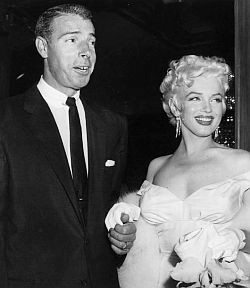 June 1955. Though in divorce proceeding, DiMaggio escorts Monroe to premiere of “Seven Year Itch”. |
On the acting front, meanwhile, she had also come to New York to study method acting at the highly regarded Actors Studio, run by Lee Strasberg, whose wife, Paula, became Monroe’s acting coach. Monroe wanted to become a better actor with the goal of getting more meaningful film roles. While Hollywood actors were not always well received at the Actors Studio, Monroe was earnest in wanting to improve her craft, and received praise from her peers.
During her time in New York area, Monroe also became acquainted with its jazz scene. Milton Greene was a good friend of Dizzy Gillespie, and he introduced Monroe to the city’s jazz clubs. In the process, Marilyn would also befriend Ella Fitzgerald. In fact, at one New York club that was refusing to engage Ella as a performer, Monroe called the manager to say if he had Ella perform there, Monroe would come to all her shows, meaning plainly that her star attendance would help fill his club.
In her love life, Monroe had kept a low profile at first following her separation from DiMaggio. However, she dated actor Marlon Brando for a time. But later, it was playwright Arthur Miller who had her full attention. Miller was a noted for popular plays such as All My Sons (1947), Death of a Salesman (1949), The Crucible (1953), and A View from the Bridge (1955). Monroe and Miller had met in 1951, had a brief affair, but remained in contact.
However, one vignette of things to come in the relationship between Marilyn and then former husband, Joe DiMaggio, came when he escorted her to the June 1st, 1955 premiere of The Seven Year Itch, the film with the famous skirt-blowing scene that contributed to the demise of their marriage.
Indeed, at the time of the film’s premiere at the Lowe’s State Theater in Times Square, New York, the divorce proceeding between Joe and Marilyn had not yet been finalized. But according to some accounts, in the years after their separation, she and Joe actually got along better than when they were married. And so, there would be more to come in their evolving friendship over the next several years.
After October 1955, Arthur Miller and Marilyn Monroe began a more serious relationship, as her divorce from DiMaggio was finalized and Miller had then separated from his wife.
Monroe’s film studio, however, urged her to end the affair with Miller since he was then being investigated by the FBI for allegations of communism and was also subpoenaed by the House Un-American Activities Committee. Monroe refused to end her involvement with Miller. The FBI, meanwhile, opened a file on Monroe.
In early March 1956, now back in Hollywood, Monroe began work on Bus Stop, her first film after studying at the Actors Studio. Her partner in MMP, Milton Greene, had purchased the film rights. Bus Stop is neither a full-fledged comedy nor a musical, but a dramatic story, although Monroe does sing one song.

May 14, 1956. Time magazine's cover story noted that Marilyn Monroe had become “a big business.”
In mid-May 1956, Monroe appeared on the cover of Time magazine. In the feature story, Time’s editors covered her biography and rise to fame, writing in part:
…the little girl grew up to be a movie star named Marilyn Monroe, and the dream came true on such a preposterous scale that her new wide world has fallen at her feet. In Hollywood’s pagan pantheon, Marilyn Monroe is the Goddess of Love. Furthermore, she has shown signs of becoming a good actress, and many a once-skeptical professional now thinks she may become an outstanding one.
…[A]nd the poor little waif has become a big business; her last five pictures have grossed more than $50 million. Moreover, there is solid evidence that she knows how to run her business…
Time had also noted that Marilyn was receiving as many as 5,000 letters a week from her fans, some including proposals of marriage.
On June 21, 1956, Arthur Miller was called to testify in Washington D.C. by the House Un-American Activities Committee. At a press conference following that hearing, Miller also made reference to marriage plans with Marilyn Monroe, although he had yet to formally proposed to her, causing a swarm of press to seek her out in New York for comment. Miller had received a citation of contempt from the HUAC committee, but the typical public backlash other HUAC witnesses had experienced, didn’t follow for Miller, which some believe was deflected by way of his involvement with Marilyn Monroe and its positive press. In any event, on June 29, 1956, Monroe and Miller were married in a small ceremony at the home of Miller’s agent in Westchester, New York. At the time, Monroe had just turned 30.
 June 29, 1956. Arthur Miller and Marilyn Monroe at cake cutting on wedding day. |
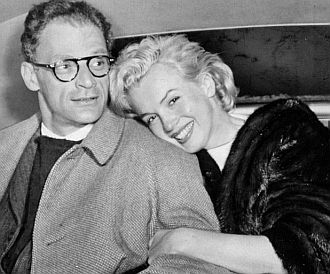 Playwright Arthur Miller and film star Marilyn Monroe in later days of their marriage. |
By August 1956, the film Bus Stop was released to theaters and became a critical and commercial success. Monroe’s performance was cheered by The Saturday Review of Literature: “effectively dispels once and for all the notion that she is merely a glamour personality.” And Bosley Crowther of the New York Times proclaimed: “…Marilyn Monroe has finally proved herself an actress.” She also won a Golden Globe nomination for the performance.
As Bus Stop was running in theaters, Monroe had begun another MMP film project, The Prince and the Showgirl in England. Monroe’s new husband, Arthur Miller, went with her, and the couple enjoyed some time together there in a somewhat extended honeymoon.
The film, however, was to be directed, co-produced, and co-star, English actor, Laurence Olivier. During production, Monroe and Olivier had their differences. Offended by some of his remarks – e.g., “All you have to do is just be sexy” – Monroe became uncooperative for a time during filming. There were also other difficulties. She and Milton Greene argued over how MMP should be run, but the film was completed on schedule by the end of 1956. The Prince and the Showgirl was released to theaters in the summer of 1957. Though unpopular in America, it did better in Europe, where she was awarded the Italian David di Donatello and the French Crystal Star awards and was nominated for a BAFTA.
After returning from England in late fall 1956, Monroe took an 18-month hiatus to concentrate on family life. For a time, her marriage to Miller seemed a positive development for Monroe. She and Miller split their time between New York city, Connecticut and Long Island. Away from Hollywood, Monroe’s life became more normal; she began cooking, keeping house and giving Miller more attention. By April 1957, however, Marilyn and Milton Greene could not settle their disagreements over MMP, and Monroe bought out his share of the company. Later that year, in August 1957, she had an ectopic/tubal pregnancy that was terminated.
By 1958, Monroe was the main breadwinner in her marriage with Arthur Miller. Not only did she pay alimony to Miller’s first wife, but he reportedly charged her production company for buying and shipping a Jaguar to the United States.
By August 1958, Marilyn Monroe was back at work in Hollywood, as filming began on Some Like it Hot, a comedy with Jack Lemon and Tony Curtis, who play two musicians who disguise themselves by dressing as women and joining an all-female band in order to escape gangsters they witnessed committing murder.
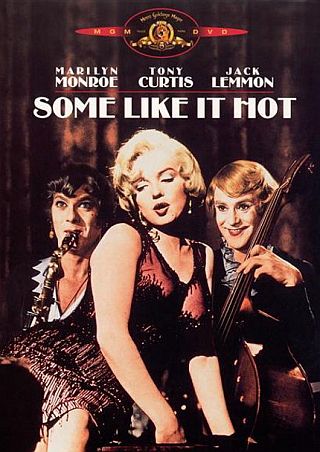
Monroe in scene with cross-dressed Curtis & Lemon in all-girl band from 1959s’ “Some Like it Hot.” Click for film.
Monroe’s performance as Sugar Kane in the film garnered her a Golden Globe for best actress in musical or comedy. Some Like It Hot is now rated as one of the best comedy films ever made. But during its production, Monroe had her personal trials, hospitalized at one point in mid-September 1958 for “nervous exhaustion” (actually a barbiturate overdose). She had also become pregnant in October 1958, though later had a miscarriage. Still, by November 1958, she finished her work on Some Like it Hot, which reached theaters by April 1959 and became a major box office hit.
By February 1960, Monroe was at work on Let’s Make Love, co-staring French actor, Yves Montand, with whom she would later begin an affair, her marriage to Miller by this time on rocky ground. By June of that year, she would also begin daily sessions with psychoanalyst Ralph Creenson. Let’s Make Love, a musical, was finished by August 1960. Shortly before its release to theaters, Monroe and Montand were featured on the cover of Life magazine in a sensual pose taken from the film. Their affair ended when filming ended, with Montand returning to France.
Then came The Misfits, a film based on Arthur Miller’s screenplay, which was adapted by Miller from his own short story of that name published in the October 1957 edition of Esquire magazine. The adaptation was meant to be a Valentine gift from Miller to Marilyn, but it became more like the death knell for their marriage. The film was directed by John Huston, starring Clark Gable, Monroe, Montgomery Clift, Eli Wallach, and others. It told a story about four “misfits” – four people who didn’t fit into society: a divorcée (Monroe), an aging cowboy trying to reclaim his mojo (Gable), a former rodeo star (Clift), and an unemployed mechanic (Wallach) all drifting along in Nevada.
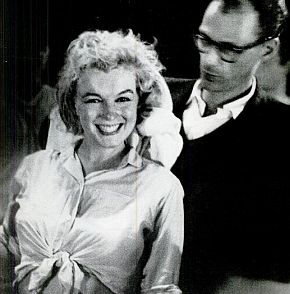 Monroe being toweled off by Arthur Miller on “Let’s Make Love” film set after 6-hr dance rehearsal. Life. |
During filming of The Misfits, Monroe became a problem, as she was taking drugs to help her sleep and more drugs to help her wake up, which caused her to arrive on the set late and then have trouble remembering her lines. Director John Houston would explain some years later: “There was evidence right before me almost every day. She was incapable of rescuing herself or of being rescued by anyone else. And it sometimes affected her work. We had to stop the picture while she went to a hospital for two weeks” (August 1960). Houston would also say he felt “absolutely certain that she was doomed.” Miller was on the movie set with Marilyn in Nevada, and was regularly reworking the screenplay as they went. It wasn’t a happy scene, as their marriage by that point was broken beyond repair. On January 24, 1961, a Mexican divorce was granted Monroe. About a year later, in February 1962, Miller would marry Inge Morath, an Austrian-born photographer who had worked on the set of The Misfits making a record of its filming,

New York Mirror story on a later June 29, 1961 Marilyn Monroe visit to New York hospital – with “Joe at side”.
Not long after her divorce from Arthur Miller and the release of The Misfits to theaters in early 1961, Marilyn Monroe was admitted to the Payne Whitney Psychiatric Clinic in New York.
On February 5th, 1961 she was involuntarily committed to Payne Whitney by her psychoanalyst, Marianne Kris. At the time, Kris told her she was going there for some “rest and relaxation.”
But Monroe was terrified of sanitariums because her mother lived in one for most of her life and her grandmother had died in one. Monroe was placed in a single room with padded walls and bars on the window. And in a later letter to her Los Angeles psychiatrist, Ralph Greenson (made public in 2015), she described verbal and mental abuse there by one doctor.
Permitted to make a telephone call at one point, she called ex-husband Joe DiMaggio, then in Florida, who by varying accounts, secured her release from Payne Whitney on February 10, 1961, while also helping arrange her admission to Columbia-Presbyterian Medical Center where she would have a normal private room where she might have some real rest.
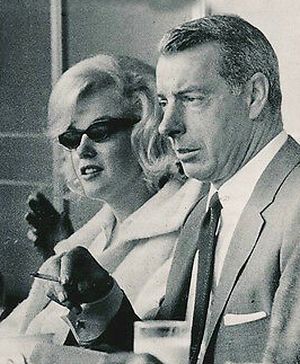
April 1961. Marilyn Monroe & Joe DiMaggio in attendance at Yankee Stadium for opening-day game.
In late March 1961 she joined DiMaggio in Florida where he was a batting coach for the New York Yankees during spring training. News photos of the pair relaxing in the Florida sun also circulated in some newspapers around this time, as the couple had taken a brief vacation.
On April 11, 1961, Marilyn and Joe attended the opening day baseball game between the New York Yankees and Minnesota Twins at Yankee Stadium, where they were photographed in attendance for stories that appeared in the next day’s newspapers
In New York, reporters had staked out her apartment building, as remarriage rumors between she and Joe had circulated, which Marilyn tamped down saying they were “just friends.”
Still, at the 33rd Academy Awards held in Santa Monica, CA on April 17, 1961, MC Bob Hope “dedicated” Best Song nominee – “The Second Time Around” – to Joe and Marilyn.
Back in Hollywood
In 1962, Monroe resumed her career in Hollywood and purchased a home in Brentwood section of Los Angeles. Joe DiMaggio, meanwhile, remained involved with and connected to Monroe during 1962. Even when he wasn’t physically with her, the two remained in contact over the phone. When Marilyn was buying her home in Brentwood in February 1962, DiMaggio loaned her $5,000 to make the down-payment. But she also continued her Hollywood life.
Among Monroe’s assortment of Hollywood friends in the early 1960s were members of the “Rat Pack,” such as Frank Sinatra and Peter Lawford. Lawford was then married to Patricia Kennedy, sister of U.S. president, John F. Kennedy (JFK).
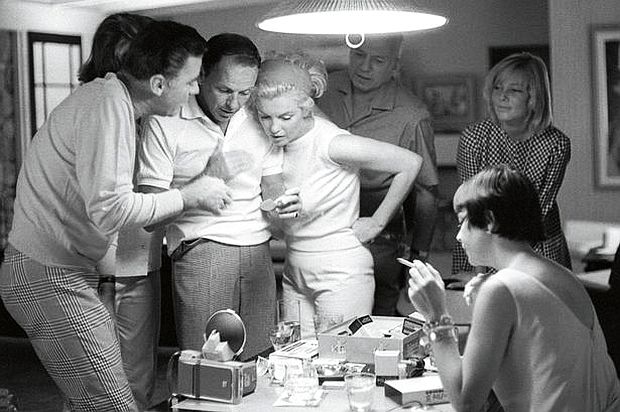
Marilyn Monroe, center, at Peter & Pat Lawford’s home in 1960, with Peter Lawford, left, and Frank Sinatra next to Monroe looking at a photographs. May Britt is standing in back shadow, at right. Shirley MacLaine is seated.
At various meetings and social gatherings at the Lawford’s house in Santa Monica – and elsewhere – Monroe had met JFK and his brother, Robert F. Kennedy. Over the years, there have been reports, through various biographies and other accounts, of Monroe having brief affairs with both JFK and RFK in the early 1960s, as well as with Sinatra, earlier, possibly in 1959.
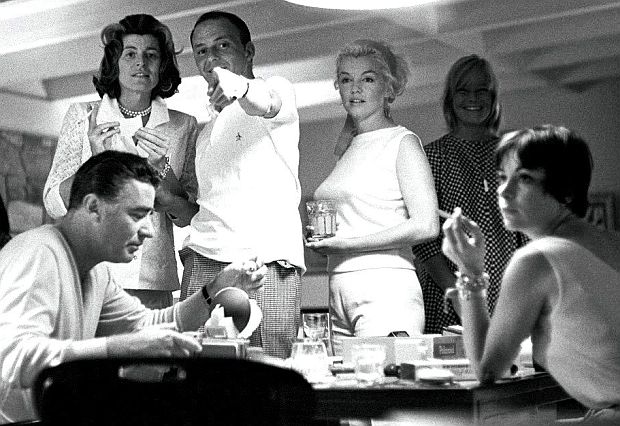
Photo of the same group as above, now showing Patricia Kennedy Lawford standing at left with Sinatra pointing, Peter Lawford at left now seated, and Shirley MacLaine at right, turning toward camera.
One Monroe biographer, Donald Spoto, has written that Monroe and JFK met four times between October 1961 and August 1962, with one intimate encounter at Bing Crosby’s house on March 24, 1962, according to Monroe’s masseur, Ralph Roberts. Another biographer, James Spada, has it that Monroe had “sexual relations with both Bobby and Jack.” Volumes have been written about these encounters, some with questionable credibility and accuracy.

June 22, 1962. Life magazine boasts on cover: “Marilyn Monroe: A Skinny-Dip You’ll Never See on the Screen”.
In the spring and summer of 1962, Monroe was also working on the film, Something’s Got to Give, a remake of an earlier comedy (My Favorite Wife, from 1940). In addition to Monroe, the film was also scheduled to star Dean Martin and Cyd Charisse, and was to be directed by George Cukor for 20th Century Fox.
The film, however, was never finally produced, disrupted in part by shooting delays due largely to Monroe’s personal troubles and absence from the set (missing 12 of 32 filming days). Still, some of the scenes Monroe had shot for the film – including a famous nude swimming pool scene – as well as a number of photographs from the set, were published, some at the time, and others years later, including film footage used in later documentaries.
Life magazine, for one, later ran the cover story shown at left with related photos inside and background on the filming (photos by Lawrence Schiller & William Woodfield).
But part of Monroe’s absence from the filming of Something’s Got To Give (and the studio’s later displeasure with her absence) was due to her attending a birthday gala for then President John F. Kennedy at New York’s Madison Square Garden on May 29, 1962. Monroe had been asked by the White House to attend the JFK gala, and before shooting had begun for Something’s Got to Give, she had notified her producer of the invitation and was cleared to attend.
JFK Gala
Meanwhile, in New York on May 29, 1962, the birthday gala for President John F. Kennedy was a huge affair – also a Democratic fundraising event. More than 15,000 people attended, including all the requisite Washington political VIPs and Hollywood royalty. Monroe would famously sing “Happy Birthday, Mr, President” for JFK on his 45th birthday, and also a few bars of “Thanks for the Memories.” Arriving late at the gala, she was introduced by Peter Lawford, and her singing performance came toward the middle-end of the program, which had included a long list of well-known entertainers.
 May 19, 1962. Peter Lawford introducing Marilyn Monroe at JFK’s birthday gala in New York city . |
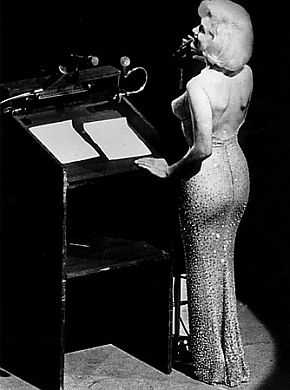 May 19, 1962. Marilyn Monroe sings “Happy Birthday, Mr. President” at JFK gala at Madison Square Garden. |
Monroe sang her tribute to President Kennedy in her most breathy, sexiest voice, while wearing a sleek, form-fitting, specially-designed dress for the occasion, made for her by designer Jean Louis. There are a number of photos of Monroe at that event, and also a few of her attending an after-party at the Manhattan residence of Arthur and Mathilde Krim. One of those photos – reportedly the only one with JFK and Monroe in the same frame, taken by Cecil Stoughton – is shown below. It also includes Robert Kennedy and JFK presidential aide and historian, Arthur Schlesinger.

May 19, 1962. Robert F. Kennedy, Marilyn Monroe, and John F. Kennedy in rare photo taken at private “after party.” Advisor and historian Arthur Schlesinger, with glasses, is shown at far right holding drink. Photo, Cecil Stoughton.
Schlesinger would later commit one impression of Monroe to his journal, recalling meeting her with the Kennedys at the gala after-party:
“…The image of this exquisite, beguiling and desperate girl will always stay with me. I do not think I have seen anyone so beautiful; I was enchanted by her manner and her wit, at once so masked, so ingenuous and so penetrating. But one felt a terrible unreality about her — as if talking to someone under water. Bobby and I engaged in mock competition for her; she was most agreeable to him and pleasant to me, but one never felt her to be wholly engaged. … She receded into her own glittering mist.”
Marilyn Fired

2001 documentary about Monroe’s last months of her life and her final, aborted feature film, “Something's Got To Give,” which was shut down after she was fired. With interviews, film footage & stills. Click for film.
Monroe, meanwhile, had lined up some magazine interviews and photo shoots – with Life, Cosmopolitan, and Vogue magazines. She also had meetings with 20th Century-Fox executives to discuss her contract and Something’s Got To Give. In the end, Fox relented and re-hired her, agreeing to pay her more than her previous salary of $100,000, with the stipulation that she make the current film and another at $500,000 per film, plus a bonus if completed on time. But filming never resumed.
In late July 1962, reportedly – July 28th – there was an incident with an over-medicated Monroe at the Cal-Neva resort at Lake Tahoe (then part-owned by Frank Sinatra), where she had come with the Lawfords to join Sinatra and others for the weekend. But after self-medicating she collapsed and was taken home to L.A. by the Lawfords. Reportedly, Joe DiMaggio was seen at the same resort at the time, though not part of the Sinatra gathering.
On August 4th, 1962, it was reported that Peter Lawford called Monroe, concerned about her health on the heels of the Cal-Neva incident. He found she was still not well and sounded quite depressed. Lawford earlier had been the bearer of unpleasant news for Monroe, telling her that all communication with JFK and Bobby Kennedy was to be cut off. She was also reportedly upset over some things JFK had said to her in private. By all accounts Monroe was in a pretty bad way at the time. In fact, on August 4th she had a spent some hours in sessions with her psychologist.
On August 5th, 1962, just before 4:00 a.m., Marilyn Monroe was found dead in her bed at her Brentwood, Los Angeles home. She was 36 years old. Empty medicine bottles were found next to her bed. A toxicology report later indicated that chloral hydrate and pentobarbital were found in her body. Her death was ruled to be “acute barbiturate poisoning” by Dr. Thomas Noguchi of the Los Angeles County Coroners Office and listed as a “probable suicide”. The news rocked the nation, and would be a major story for weeks, with newspaper features, magazine specials, and TV reporting.
 NY Daily News of August 6, 1962 announcing death of Marilyn Monroe with 7 pages of stories & pictures. |
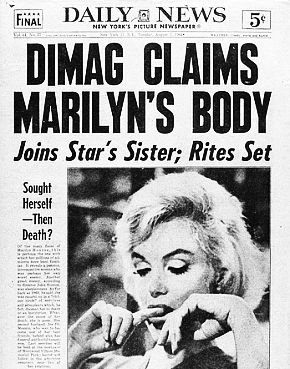 NY Daily News of August 7, 1962 announcing Joe DiMaggio role in claiming her body & funeral rites. |
But it was Joe DiMaggio who claimed her body and helped manage her funeral, barring most of Hollywood from attending. In fact, DiMaggio, according to later biographers, believed that it was the Kennedys and the Hollywood crowd who drove Monroe to her desperate lengths. He still loved her and was devastated. Honoring a request she had made of him back in 1954, DiMaggio faithfully had fresh roses delivered to Monroe’s crypt twice a week until his own death in 1999.
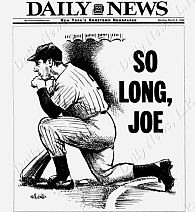
March 8, 1999. NY Daily News back page tribute at Joe DiMaggio's passing.
Media, Books, Film
The Joe DiMaggio / Marilyn Monroe story, however, did not end with either Marilyn’s death in 1962 or DiMaggio’s passing in 1999. The publishing world and the media kept their story alive, in one form or another, for decades. Of course, it has been “the Marilyn Monroe story” that is the primary driver of the media’s continued fascination — with DiMaggio as one part of her story. Still, it is the Monroe travail that has been center stage; told and re-told and spun with all manner of twists and turns, and fueled in later years with conspiracy theories about her death. In any case, the parade of magazine stories, books, films, and on-line lore about Marilyn Monroe is seemingly never ending – some by friends who knew her, business associates, fellow actors and directors, celebrity writers, photographers, documentary film producers and more. All have kept her story going in one form or another for more than 70 years and counting.

|

|

|
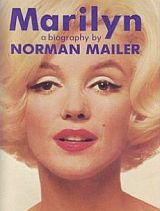
|

|

|
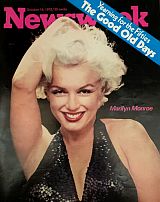
|

|
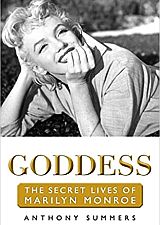
|

|

|
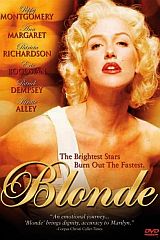
|

|

|

|
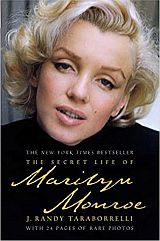
|
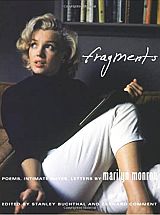
|
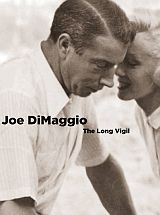
|

|
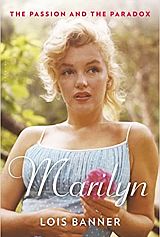
|

|

|

|

|

|
A sampling of some of these various works, mostly books, is offered here with cover art in the columns at right (click on images for Amazon.com pages). Others appear in the “Sources” section at the end of this story. This sampling, however, is just that, as hundreds of books alone, have been written about Monroe.
Among early reporting, for example, was an August 7, 1964 Life magazine feature story by Claire Boothe Luce (wife of publisher Henry Luce), “Marilyn Monroe: What Really Killed Her,” with Marilyn on the cover.
In 1966, a documentary film titled, The Legend of Marilyn Monroe, appeared, chronicling her life and career, narrated by John Huston, also reissued in later years. By the late 1960s, other books followed: in 1967, Marilyn: An Untold Story by Norman Rosten came out and in 1969, Norma Jean: The life of Marilyn Monroe by Fred Lawrence Guiles was published.
In August 1972, Ms. Magazine story ran with the title, “Ten Years Later: The Real Marilyn Monroe: The Woman Who Died Too Soon.” In 1973, Norman Mailer’s Marilyn: A Biography (paperback edition shown), sparked controversy with its final chapter that claimed Monroe was murdered by agents of the FBI and CIA who resented her affair with Robert F. Kennedy. Mailer’s wasn’t the first conspiracy offering about her death, as a number of others would follow.
In 1977, one of the first books focused on the “Joe & Marilyn” story appeared with Robin Moore and Gene Shoor’s book, Marilyn & Joe DiMaggio. Sportswriter Roger Kahn’s book, Joe & Marilyn: A Memory of Love, published by William Morrow (269 pp.) appeared later in 1986 (paperback edition shown at right).
A decade after her death, in mid October 1972, Newsweek ran a cover with a Marilyn Monroe photo, casting her as a nostalgia figure with a banner that read: “Yearning for The Fifties: The Good Old Days.” Ten years later, in July 1982, at the 20th anniversary of her death, McCall’s magazine put her on the cover along with story taglines: “What She Feared The Most,” and “What She’d Look Like Today.” Life magazine, also commemorating her 20-year passing, put Monroe on its August 1982 cover with story tagline: “The Unseen Marilyn: Never Published Photographs – 20 Years After Her Death.”
In 1985, Anthony Summers’ book, Goddess: The Secret Lives of Marilyn Monroe, was published. Based on over 600 interviews it became a New York Times bestseller. Its later paperback version is shown at right.
In May 1993, Donald Spoto’s Marilyn Monroe: The Biography, was published by Harper Collins, coming in just under 700 pages and is among the most read Monroe biographies.
Meanwhile, in fiction, Joyce Carol Oates published Blonde, her best-selling 2000 historical novel about Monroe that was a finalist for the Pulitzer Prize and the National Book Award. In May 2001, the popular novel was adapted into a CBS TV mini-series of the same name with Australian actress Poppy Montgomery cast as Monroe in the lead role. Another film version of Blonde, also based on the Joyce Carol Oates novel, is scheduled for release by Netflix in 2022. Oates’ novel, meanwhile, was reissued in April 2020 in a 20th anniversary edition.
After the death of Joe DiMaggio in 1999, there was Richard Ben Cramer’s best-selling, Joe DiMaggio: The Hero’s Life, published in 2000 by Simon & Schuster. It included quite a bit of Marilyn Monroe narrative.
In September 2006, a Marilyn Monroe autobiography appeared with the tile, My Story, written with Bent Hecht and illustrated with Milton Greene photographs.
In the Sunday supplement world, meanwhile, the July 28th, 2008 edition of Parade magazine ran a cover story entitled, “The Marilyn You Don’t Know” by Liz Smith.
In August 2009, J. Randy Tarabor-relli’s The Secret Life of Marilyn Monroe (576 pp.) was published, becoming a New York Times bestseller.
A year later, in October 2010, Monroe’s Fragments: Poems, Intimate Notes, Letters (from her estate) was published by Farrar, Straus and Giroux, edited by Bernard Comment. This book had a popular following and was positively received by many readers.
In March 2011, Jerome Charyn’s book, Joe DiMaggio: The Long Vigil, was published by Yale University Press (192 pp).
My Week with Marilyn is a 2011 film drama starring Michelle Williams as Monroe, along with Kenneth Branagh, Dominic Cooper, Julia Ormond, Emma Watson, Judi Dench and others, based on two books by Colin Clark depicting the making of the 1957 film, The Prince and the Showgirl. Released in November 2011 in the U.S. and UK, the film received generally positive reviews, while Williams and Branagh were nominated for Academy Awards.
In July 2012, Lois Banner’s Marilyn: The Passion and the Paradox was published by Bloomsbury USA (528 pp). Banner is one of the founders of the field of women’s history.
In November 2012, HBO aired the documentary film, “Love, Marilyn,” which is performed through the readings of Monroe’s personal diaries and letters by more than 20 actors and others – Elizabeth Banks, Ellen Burstyn, Glenn Close, Viola Davis, etc – exploring her life and personal thoughts. “…[T]his slick documentary,” said one New York Times review, “is also a respectful love letter to Monroe…”
In May 2015, “The Secret Life of Marilyn Monroe” aired as a made-for-TV drama miniseries on the Lifetime channel. Based on J. Randy Taraborrelli’s 2009 bestseller of the same name (listed earlier above), the film starred Kelli Garner, Susan Sarandon, Emily Watson, and others.
Among books by various photographers featuring still photos of Monroe is David Wills’ 2015 book, Marilyn In the Flash: Her Love Affair With The Press, 1945-1962, published by Dey Street Books (256 pp). There are at least 80 other photographers who did work with Monroe, some with their own books.
A 2005 PBS American Masters documentary, “Marilyn Monroe: Still Life,” claims she was the most photographed person in history.
Over the years since her death, a number of popular magazines – Time, Life, Newsweek, Playboy and others – have run various special collections or anniversary editions on Monroe. In April 2016, Vanity Fair turned out one of these special editions for her 90th birthday, “Marilyn Monroe: The Movies, The Myths, The Men.”
In May 2018, Michelle Morgan’s book, The Girl: Marilyn Monroe, The Seven Year Itch, and the Birth of an Unlikely Feminist was published by Running Press (320 pp). And in August of that year, Charles Casillo’s book, Marilyn Monroe: The Private Life of a Public Icon (368 pp), was published by St. Martin’s Press.
Again, the above listing of books, films, and documentaries on Marilyn Monroe — and others appearing below in “Sources” — is only offered as an historic sampling, and does not comprise a complete list. As this is written in early 2022, a four-part CNN documentary, Reframed: Marilyn Monroe, has appeared, and with the 60th anniversary of her death in August 2022, there will likely be more Monroe offerings to come.

“Candle in the Wind” - Fabled legacy, troubled soul. MM in pensive moment captured by Richard Avedon, NY, May 1957.
Variety and VH1 list her in the top ten of 20th century pop culture icons. She has also influenced a range of artists and entertainers, from Andy Warhol to Madonna.
A valuable business asset in life and in death, she has appeared in ads for Chanel, Mercedes-Benz, and Absolut Vodka, among others.
In 2011, Forbes magazine listed her as the third highest-earning dead celebrity, with an income at that time of $27 million. She also appeared on the same Forbes list, 2018-thru-2020.
Wikipedia’s page, “Marilyn Monroe in Pop-ular Culture,” offers an extensive listing of her influence across film, photography, art, music, theater, and more. There are also a number of fan clubs and websites about her.
Yet, despite her cultural renown, Marilyn Monroe was a tortured soul for much of her short life, dealing with a series of troubled relationships and sizeable insecurities while trying to make her way in the often exploitive world of Hollywood entertainment.
Of related possible interest at this website are the following stories: “The Jack Pack, Pt. 2,” mostly about JFK and Rat Pack celebrities, but also includes a section on Marilyn Monroe; “Candle in Wind,” a 1973 hit song by Elton John about Monroe; and the “Rosie The Riveter” story, with sidebar, “Marilyn ‘Rosie’ Monroe,” exploring her time in WWII factory where she was discovered by photographer David Conover.
Thanks for visiting — and if you like what you find here, please make a donation to help support the research, writing, and continued publication of this website. Thank you.- Jack Doyle
|
Please Support Thank You |
____________________________________
Date Posted: 19 February 2022
Last Update: 30 September 2022
Comments to: jdoyle@pophistorydig.com
Article Citation:
Jack Doyle, “Marilyn & Joe, et al., A 70 Year Saga,”
PopHistoryDig.com, February 18, 2022.
____________________________________
Sources, Links & Additional Information
“Joe DiMaggio,” Wikipedia.org.
“Marylin Monroe,” Wikipedia.org.
Marilyn Monroe, Biography online (by Donald Spoto), erenow.net.
Aline Mosby, “Marilyn Monroe Admits She’s Nude Blonde of Calendar,” Los Angeles Herald Examiner, March 13, 1952.
“Hollywood Topic A-Plus; Whole Town’s Talking About Marilyn Monroe,” Life, April 7, 1952, pp, 101-103 (w/cover photo by Philippe Halsman).
“The Monroe Doctrine,” Life, April 7, 1952, p. 104.
“Cinema: Something for the Boys,” Time, August 11, 1952.
“Location Loafing: With Wide Screen Waiting For Colossal Backgrounds, Hollywood Production Moves to the Canadian Rockies,” and “Stars Enjoyed Both Work And Play in Beautiful Canadian Parks,” Look (magazine photos by John Vachon), October 20, 1953.
United Press, “Sure There Will Be A Family, Couple Murmurs In Confusion” (w/photo), The Commerical Appeal (Memphis, TN), January 15, 1954, p. 1.
“The Seven Year Itch,” Wikipedia.org.
Dennis Gaffney, “The Breakup with Marilyn,” article from, Joe Dimaggio: The Hero’s Life (aired May 8, 2000), American Experience / PBS.org.
“Tearful Photos From the Day Marilyn Divorced DiMaggio in 1954″ (George Silk photos), Life.com.
United Press (Hollywood), “Free Marilyn Says Joe Treated Her ‘Coldly’,” October 27, 1954.
Michael Beschloss, “DiMaggio and Sinatra: The Feud Between Two Italian-American Pathbreakers,” New York Times, June 13, 2014 (includes “wrong door raid” of November 5, 1954).
Thomas M. Pryor, “Marilyn Monroe Fails to Report; Fox Again Puts Star Under Salary Suspension for Missing ‘Pink Tights’ Call,” New York Times, January 26, 1954.
“April 8 1955: Monroe Appeared on ‘Person to Person’,” WorldHistoryProject.org.
“Marilyn Monroe Rare Live Television Appearance – ‘Person To Person’ Interview 1955 [April 8],” YouTube.com, posted, August 17, 2013.
Ian Wilson, “Joltin’ Joe Has Left & Gone Away,” AlbertaDugoutStories, August 28, 2020.
“Joe DiMaggio, Marilyn, Find Jasper Tops,” [Jasper, Alberta], Vancouver Sun, (Vancou-ver, British Columbia), August 5, 1953.
Susan Doll, “Marilyn Monroe’s Later Career; Marilyn Monroe Productions,” HowStuff Works.com.
Pete Martin, “The New Marilyn Monroe” (three-part series), The Saturday Evening Post, May 5–19, 1956.
“To Aristophanes and Back,” Time (Marilyn Monroe cover story), May 14, 1956, pp, 75-77, 79-82.
“Actress Loses Baby; Marilyn Monroe Is Recovering in Hospital After Operation,” New York Times, August 3, 1957.
“A Comic Marilyn Sets Movie Aglow,” Life (cover story), April 20, 1959 (photographed by Richard Avedon).
“Arthur Miller,” Wikipedia.org.
“Marilyn’s’ Co-star, Yves Montand, Idol of France,” Life (cover story), August 15, 1960 (photographed by John Bryson).
David Zeitlin, “A Legend Is Costly But It’s Worth It,” Life, August 15, 1960., p. 68.
Jeffrey Meyers, The Genius and the Goddess: Arthur Miller and Marilyn Monroe, University of Illinois Press, 2010.
Murray Schumach, “Film Starring Marilyn Monroe And Dean Martin Shelved by Fox,” New York Times, June 12, 1962.
“Spotlight: Marilyn Monroe: She is Fired From Film But Her Skinny-Dip Scene Lives On,” Life (cover story), June 22, 1962, p. 82 (photos, Lawrence Schiller and William Read Woodfield).
“In 12 Years, 23 of Marilyn Monroe’s Pictures Grossed $200 Million,” Los Angeles Times, August 6, 1962, p. 2.
Bosley Crowther, “Actress as a Symbol,” New York Times, August 6, 1962.
“Brilliant Stardom and Personal Tragedy Punctuated the Life of Marilyn Monroe,” New York Times, August 6, 1962.
“Movies: The Only Blonde in the World” [obituary], Time, August 10, 1962, p. 45.
“Private World of Marilyn; She Relives Tragic Childhood,” Daily News (New York), August 15, 1962.
“Memories of Marilyn,” Life, August 17, 1962 (photographed by Lawrence Schiller).
“Death of Marilyn Monroe,” Wikipedia.org.
Gay Talese, “The Silent Season of a Hero,” Esquire, July 1966.
“A New Book Links President Kennedy To Marilyn Monroe,” New York Times, December 14, 1973.
Robin Moore and Gene Shoor, Marilyn & Joe DiMaggio, 1977, New York: Manor Books, 298 pp.
Anthony Summers, “JFK, RFK, And Marilyn Monroe: Power, Politics And Paramours?,” The Sun-Sentinel (Fort Lauderdale, FL), October 27, 1985.
Robert Lindsey, “New Inquiry Rejected in Marilyn Monroe’s Death,” New York Times, November 23, 1985.
John Corry, “On Channel 5, ‘Last Days of Marilyn Monroe’,” New York Times, November 26, 1985.
Diana Trilling, “’Please Don’t Make Me a Joke’,” Review of Gloria Steinem book, Marilyn, Phonographs by George Barris, 182pp, Henry Holt & Co., 1986, New York Times Book Review, Sunday, December 21, 1986, Section 7, p. 1.
James Spada, “The Man Who Kept Marilyn’s Secrets,” Vanity Fair, May 1991.
Richard Ben Cramer, “The DiMaggio Nobody Knew,” Newsweek, March 22, 1999.
Richard Ben Cramer, Joe DiMaggio: The Hero’s Life, Simon & Schuster, 2000.
Excerpts from Richard Ben Cramer’s book, Joe DiMaggio: The Hero’s Life, @ ESPN.com, January 16, 2000.
“Author Richard Ben Cramer Shares His New Book, ‘Joe DiMaggio: The Hero’s Life’,” The Charlie Rose Show /CharlieRose.com, November 16, 2000.
Jillian Sim, “A Marilyn Monroe Chronology,” Americaneritage.com, November/December 2005, Vol 56, No. 6.
Maureen Dowd, “Social Historian” (Review of Arthur M. Schlesinger, Jr.’s, Journals, 1952-2000), New York Times, October 7, 2007.
J. Randy Taraborrelli, The Secret Life Of Marilyn Monroe, New York: Grand Central Publishing, August 2009, 576 pp.
John Berman, “JFK and Marilyn Monroe: The Story Behind the Image,” Good Morning America/ABCNews.com, June 1, 2010.
“JFK and Marilyn Monroe Snapped Together,” Good Morning America (ABC News), video.
“The Night Marilyn Sang to JFK,” Photo Gallery, Life.com.
Alan Duke, “Rare Photo Shows Marilyn Monroe with JFK, RFK,” CNN.com, June 2, 2010.
Scott Harrison, “Retrospective: Marilyn Monroe and Joe DiMaggio Divorce,” Los Angeles Times, October 4, 2012. (includes photos)
Ethan Sacks, “Playboy Honors Marilyn Monroe with Nude Photo Special Spanning Her Career,” New York Daily News, November 19, 2012.
David DeWitt, “Movie Review, ‘Love, Marilyn’: Looking at Words, Letters and Lists of Marilyn Monroe,” New York Times, November 29, 2012.
J Randy Taraborrelli, “Joe DiMaggio Wanted Marilyn Monroe to Be His Demure Housewife…” Daily Mail (U.K.), September 1, 2009.
Carter Witt, “Marylin and Joe In Japan,” Japan-Zine.com, October 2000.
“Joe & Marilyn,” NPR.org, May 13, 2006.
Pat Ryan, “Marilyn’s Manhattan, Both Public and Private,” New York Times, January 6, 2011.
Pat Ryan, “The Prince, the Showgirl, and the Stray Strap,” New York Times, November 11, 2011.
Elizabeth Blair, “Monroe’s Legacy is Making Fortune, But For Whom?,” NPR.org / All Things Considered, August 3, 2012.
Isabelle Raphae, “The 60th Anniversary of Marilyn Monroe and Joe DiMaggio’s Wedding: See the Photos,” Parade.com, January 14, 2014.
Maureen Callahan, “Inside DiMaggio and Monroe’s Twisted Love,” NYPost.com, June 8, 2014.
Lisa Liebman, “Never-Before-Seen Photo-graphs of Marilyn Monroe by Her Friend Milton Greene,” VanityFair.com, September 20, 2017.
Jess Catcher, “Marilyn Monroe and Joe DiMaggio: A Look Back at Their Bittersweet Romance,” WomansWorld.com, January 13, 2019.
Liz Ronk, “Marilyn Monroe: The Life Covers, 1952-1962,” Time.com, August 24, 2014.
Lily Rothman, “The Best Response Ever to a Celebrity Nude Photo Scandal,” Time.com, September 2, 2014.
Jessica Sager, “The Way They Were: Marilyn Monroe and Joe DiMaggio’s 61st Anniversary” (photos), New York Post, January 14, 2015.
Lily Rothman, “How Marilyn Monroe Became a ‘Real Actress’,” Time.com, June 1, 2016.
Sam Gillette, “New Book Reveals Joe DiMaggio’s Torment After Marilyn Monroe’s Death: ‘I Always Knew Who Killed Her’,” People.com, May 9, 2017.
Les Harding, They Knew Marilyn Monroe: Famous Persons in the Life of the Hollywood Icon, McFarland & Co., 2012.
Olivia B. Waxman, “The Story Behind the Only Known Photo of Marilyn Monroe and John F. Kennedy Together,” Time.com, August 3, 2018.
“43 Rare Photos from Marilyn Monroe’s Turbulent Marriages,” ELLE.com. September 16, 2020.
“Marilyn Monroe in Popular Culture,” Wiki-pedia.org.
Dennis Gaffney, “The Breakup With Marilyn,” from, American Experience, “Joe DiMaggio: The Hero’s Life,” PBS.org/WGBH.
Liesl Bradner, “When Marilyn Monroe Interrupted Her Honeymoon to Go to Korea,” HistoryNet.com, Winter 2020.
“Something’s Got to Give,” Wikipedia.org.
Angelica Jade Bastién, “Every Marilyn Monroe Movie, Ranked From Worst to Best,” Vulture .com, August 31, 2017.
